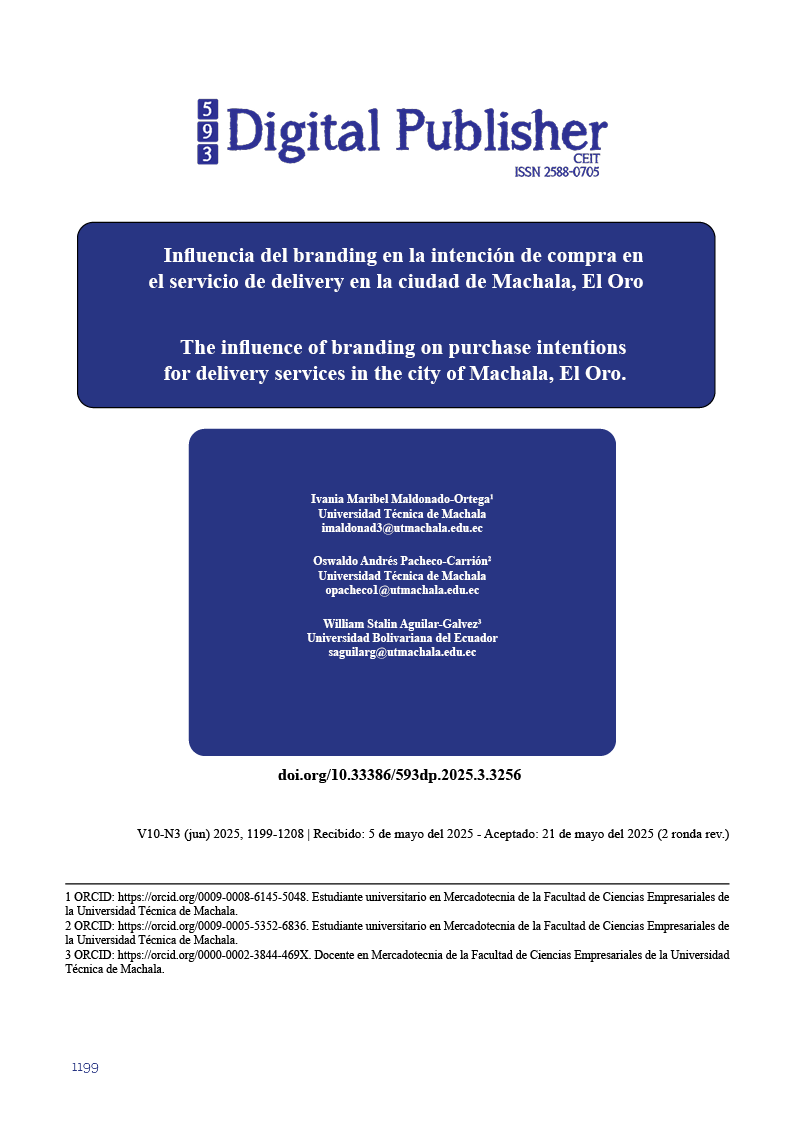The The influence of branding on purchase intentions for delivery services in the city of Machala, El Oro.
Main Article Content
Abstract
The objective of this research is to analyze the influence of branding on the purchase intention within the delivery sector in the city of Machala, El Oro. For this purpose, the variables naming and graphic brand were evaluated as key components in the construction of branding, and how this, in turn, affects the purchase decision of consumers. In this context, a quantitative approach was applied with partial least squares structural equation modeling (PLS-SEM) on a sample of 250 people belonging to the Z and millennials generations, aged between 20 and 40 years. Data were collected through an online Likert-scale questionnaire. The results confirmed that naming and graphic branding significantly influence branding, and that branding has a direct impact on purchase intention. Finally, it is concluded that consciously adopting branding strategies can strengthen consumer loyalty, improve the positioning of local companies and increase their competitiveness in today's digital environment.
Downloads
Article Details

This work is licensed under a Creative Commons Attribution-NonCommercial-ShareAlike 4.0 International License.
1. Derechos de autor
Las obras que se publican en 593 Digital Publisher CEIT están sujetas a los siguientes términos:
1.1. 593 Digital Publisher CEIT, conserva los derechos patrimoniales (copyright) de las obras publicadas, favorece y permite la reutilización de las mismas bajo la licencia Licencia Creative Commons 4.0 de Reconocimiento-NoComercial-CompartirIgual 4.0, por lo cual se pueden copiar, usar, difundir, transmitir y exponer públicamente, siempre que:
1.1.a. Se cite la autoría y fuente original de su publicación (revista, editorial, URL).
1.1.b. No se usen para fines comerciales u onerosos.
1.1.c. Se mencione la existencia y especificaciones de esta licencia de uso.
References
Bleize, R., Carpio, L., & Torres, A. (2019). Intención de compra en el entorno digital: Análisis en jóvenes consumidores. Revista de Marketing Digital, 15(2), 45–58.
Ferrari, M., López, D., & Vargas, P. (2020). Estrategias de naming y posicionamiento de marca en mercados saturados. Revista Branding y Sociedad, 12(3), 87–105.
Fernández Rincón, A. (2019). El diseño gráfico de la marca en entornos digitales. Editorial UOC.
Gallardo, J. (2019). Evolución del emprendimiento tras la pandemia: Análisis del GEM 2020 y 2021. Revista Global de Emprendimiento, 7(1), 14–28.
García, J., Rivas, D., & Toledo, S. (2021). Innovación comercial y adaptación digital en la pandemia COVID-19. Estudios Empresariales, 29(4), 95–112.
Ilgo, D. (2019). Gestión estratégica de marca y percepción del consumidor. Editorial Universitaria.
Imtiaz, A., Zahra, S., & Malik, T. (2019). Purchase intention: A study of behavioral predictors in the digital era. International Journal of Consumer Studies, 43(2), 155–163.
López, M., Bravo, S., & Cabrera, R. (2022). Ventajas competitivas a través del branding en pequeñas empresas latinoamericanas. Revista Perspectivas Empresariales, 10(2), 101–117.
Martínez, L., Arévalo, C., & Chamba, M. (2024). Aplicación de PLS-SEM en estudios de neuromarketing. Revista de Métodos Cuantitativos, 18(1), 56–73.
Maza-Maza, M., Ortega, F., & Espinoza, R. (2020). Branding emocional y decisión de compra en plataformas digitales. Cuadernos de Marketing, 5(2), 10–20.
Montalván, A., Herrera, J., & Cueva, T. (2024). Diferenciación y estrategias de branding en mercados competitivos. Revista Latinoamericana de Mercadotecnia, 13(1), 22–38.
Mouboua, A., Torres, K., & Núñez, C. (2024). Compromiso ético de marca y fidelidad del consumidor. Revista de Psicología del Consumo, 9(3), 88–102.
Peña-García, N., Gil, S., & Ramírez, A. (2020). Intención de compra en comercio electrónico: Un análisis por segmentos. Journal of Digital Commerce, 7(1), 34–50.
Pogacar, R., Baek, T. H., & Warren, C. (2021). The role of visual design in branding: Effects on recognition and trust. Journal of Marketing Research, 58(2), 321–338. https://doi.org/10.1177/0022243720986721
Reinartz, W., Haenlein, M., & Henseler, J. (2009). An empirical comparison of the efficacy of covariance-based and variance-based SEM. International Journal of Research in Marketing, 26(4), 332–344. https://doi.org/10.1016/j.ijresmar.2009.08.001
Sarstedt, M., Hair, J. F., Cheah, J. H., Becker, J.-M., & Ringle, C. M. (2022). How to specify, estimate, and validate higher-order constructs in PLS-SEM. Australasian Marketing Journal, 30(1), 3–11. https://doi.org/10.1016/j.ausmj.2021.05.005
Schmidt, C., Pérez, M., & Villacís, G. (2015). Tecnologías de la información en procesos logísticos: El caso del delivery urbano. Revista Logística y Transporte, 9(2), 44–59.
Sonorza, A., Díaz, M., & Torres, F. (2021). Hábitos de consumo y uso de plataformas de delivery durante y después de la pandemia. Revista Economía Digital, 8(1), 75–91.
Vasilica, M. (2022). Motivación y comportamiento del consumidor en decisiones de compra online. European Journal of Marketing Behavior, 19(3), 112–129.
Vasilica, M., Flores, A., & Jiménez, V. (2023). Uso del modelo PLS-SEM en investigaciones de marketing predictivo. Latin American Journal of Business Studies, 12(4), 50–69.




